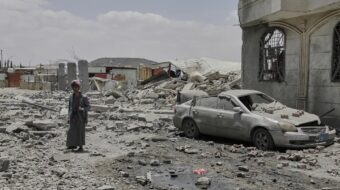DRESDEN — A large-scale anti-fascist action Feb. 13 ended with brutal violence here.
Feb. 13 has, for years, been a day of solemn ceremonies in this city on the Elbe, the capital of Saxony. It marks the date, in 1945, when British and American planes destroyed the heart of Dresden, a treasure chest of baroque architecture created largely by Italian architects, engineers and workers imported by August the Strong in the 1700’s, when he became a Catholic so as to gain the throne in neighboring Poland.
The number of air-raid victims is now estimated to have been at least 25,000 people, killed by bombs or the fire storm raging through the streets.
Historians still argue about Dresden’s military importance. Some say it was already clear it would be a key center of the Soviet Occupation Zone and the bombing, like the atomic bombs dropped on Japan, was a first blow in the Cold War, a show of strength and veiled threat to the Soviets.
In recent years, new sources of conflict have arisen. Saxony is a traditionally important East German industrial area whose textile, machine tool and electronics industries were decimated by German unification. Young people with skills and ambition, especially women, went west in the search for jobs. Others who remained, often young men with little training, few opportunities and less hope, were prey to recruitment by demagogic neo-Nazi organizers who swiftly moved into eastern Germany after the unification.
The local authorities –out of opportunism, fear or sympathy — often tolerate the Nazis.
Meanwhile the neo-Nazi movement has become two-pronged in nature. Gangs of young thugs do the bloody work, striking at “Zecken” (ticks, their word for leftists), Turks, Arabs, Africans, Poles or Vietnamese while slicker men in ties and suits join hometown clubs and organizations, run local fairs with games and goodies for the kids, and win seats in city and county councils — and nine seats in the state legislature of Saxony. Today, Nazis are adopting slogans critical of the government on economic issues, though always “anti-foreigner” in nature, demanding “Jobs for Germans.” In the past they avoided anti-Semitic slogans or banners. Now, however, with horror at atrocities in Gaza and Palestine on the increase (despite the official German alliance with the Israeli government), the Nazis are trying to misuse these sentiments to spread anti-Semitism.
One propaganda ploy of the Nazi “legislators” has been to label the destruction of Dresden a “Bombing Holocaust,” thus playing down the magnitude of the real Holocaust while appealing to still strong emotions of the Dresdeners, many of whom lost parents or grandparents in the air raid. So every year the Nazis hold a “memorial march” in Dresden to mark the date. Since the pro-Nazi National Democratic Party is legal, they can get permits for demonstrations if they keep to bans on swastikas, Hitler salutes and the like.
Some 6,000 Nazis were mustered from all over Germany, from Slovakia, the Czech Republic, even Sweden. They marched from the Main Station into the center of town, aided by the 4,300 police assigned to Dresden. Their demonstration was called a good start into the election campaigns later this year, both in Saxony and in all Germany.
The anti fascists, numbering about 12,500, were in a clear majority, but were divided. The largest group paraded to another central square with flags, balloons and banners, under the Spanish Civil War slogan “No pasaran,” and was led by Gregor Gysi from The Left, Claudia Roth from the Greens, Franz Muentefering from the SPD and several union leaders. Carefully separated from this group was a much smaller, silent march led by the Minister President of Saxony and the mayor of Dresden, both members of the ruling Christian Democratic Union.
The three marches remained peaceful, by and large, – but had a brutal aftermath. When two busloads of antifascists stopped at a highway restaurant on their way home, they were attacked by over 40 Nazis in a bus which had followed them. Several of the union members, peace activists and Left Party members were beaten. Two, not so quick to make it back to their bus, were hurt very seriously, one with a broken kneecap, the other with a serious skull fracture. The police were blamed for not taking precautions to prevent such incidents after the Dresden demonstrations had ended. According to antifascist spokespersons, the attack was one more proof that the visible, legal activities of the NPD were camouflage for brutal bands of goons and thugs.









